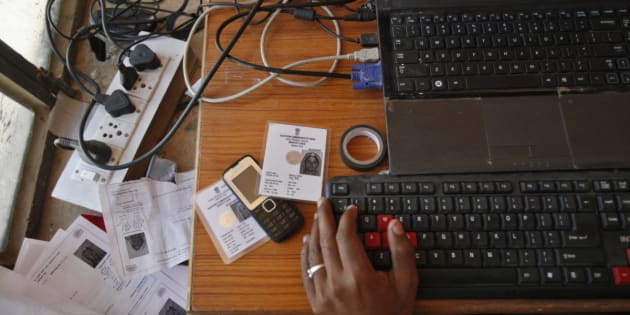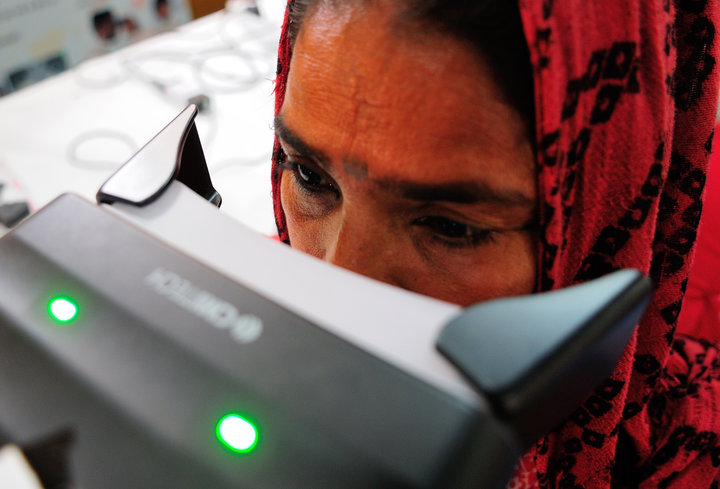ગુજરાતીમાં વાંચો
Gifted programmers crippled security highlights of Aadhaar enrollment programming, flowed hack on Whatsapp
An administrator takes a shot at his table while selecting villagers for the Unique Identification (UID) database framework at an enrollment focus in Rajasthan.
NEW DELHI—The legitimacy of the information put away in India's questionable Aadhaar character database, which contains the bio-metrics and individual data of more than 1 billion Indians, has been imperiled by a product fix that impairs basic security highlights of the product used to select new Aadhaar clients, a multi month-long examination by HuffPost India uncovers.

The fix—openly accessible for as meager as Rs 2,500 (around $35)— permits unapproved people, based anyplace on the planet, to create Aadhaar numbers freely, is still in across the board utilize.
Indian experts have declined remark, in spite of HuffPost India connecting with both NCIIPC and the Unique Identification Authority of India (UIDAI) over and over since July this year.
While NCIIPC asked for a duplicate of the fix, which HuffPost India gave around the same time, the office has declined to share its discoveries. UIDAI did not react to HuffPost India's sends.
This has critical ramifications for national security when the Indian government has tried to make Aadhaar numbers the highest quality level for resident recognizable proof, and required for everything from utilizing a cell phone to getting to a ledger.
A fix is a heap of code used to adjust the usefulness of a product program. Organizations regularly utilize patches for minor updates to existing projects, however they can likewise be utilized for hurt by presenting a helplessness—as for this situation.
HuffPost India is in control of the fix, and had it broke down by three globally presumed specialists, and two Indian investigators (one of whom looked for secrecy as he works at a state-subsidized college), to find that:

The fix gives a client a chance to sidestep basic security highlights, for example, biometric confirmation of enrolment administrators to create unapproved Aadhaar numbers.
The fix impairs the enrolment programming's in-fabricated GPS security include (used to distinguish the physical area of each enrolment focus), which implies anybody anyplace on the planet — say, Beijing, Karachi or Kabul — can utilize the product to select clients.
The fix decreases the affectability of the enrolment programming's iris-acknowledgment framework, making it less demanding to parody the product with a photo of an enlisted administrator, as opposed to requiring the administrator to be available face to face.
The specialists counseled by HuffPost India said that the helplessness is natural for an innovation decision made at the initiation of the Aadhaar program, which implies that settling it and other future dangers would require changing Aadhaar's basic structure.
"Whomever made the fix was profoundly energetic to trade off Aadhaar," said Gustaf Björksten, Chief Technologist at Access Now, a worldwide innovation strategy and backing gathering, and one of the specialists who examined the fix at HuffPost India's ask.
"There are most likely numerous people and substances, criminal, political, residential and remote, that would get enough advantage from this trade off of Aadhaar to make the interest in making the fix beneficial," Björksten said. "To have any desire for anchoring Aadhaar, the framework configuration would need to be profoundly changed."
Bengaluru-based digital security investigator and programming engineer Anand Venkatanarayanan, who likewise broke down the product for HuffPost India and imparted his discoveries to the NCIIPC government expert, said the fix was amassed by joining code from more established adaptations of the Aadhaar enrolment programming—which had less security highlights—on to more current renditions of the product.
NCIIPC, or National Critical Information Infrastructure Protection Center, is the nodal office in charge of Aadhaar security.
Venkatanarayanan's discoveries were affirmed by Dan Wallach, Professor of Computer Science, and Electrical and Computer Engineering, at Rice University in Houston, Texas.
"Having taken a gander at the fix code and the report introduced by Anand, I feel really great saying that the report is right, and it could enable somebody to dodge safety efforts in the Aadhaar programming, and make new passages. This is truly practical, and looks like something that would be conceivable to build," Wallach said.
A SERIES OF PRAGMATIC CHOICES
The beginning of the present hack lies in a choice, made in 2010, to give private organizations a chance to select clients to the Aadhaar framework with a specific end goal to accelerate enrolments. That year, Mindtree, a Bengaluru-based organization, won an agreement to build up an official, institutionalized enrolment programming — called the Enrolment Client Multi-Platform (ECMP)— that would be introduced onto the a huge number of PCs kept up by these private administrators.
Aside from private enrolment organizations, the UIDAI additionally consented to enrolment arrangements with "basic administration focuses" — town level PC stands that assistance nationals get to regular e-administration administrations, for example, benefits, understudy grants and so forth. By February 2018, these focuses were in charge of enlisting 180 million Indians.
Reference: Huffington Post, 11th September,2018 10:08 AM IST
Gifted programmers crippled security highlights of Aadhaar enrollment programming, flowed hack on Whatsapp
An administrator takes a shot at his table while selecting villagers for the Unique Identification (UID) database framework at an enrollment focus in Rajasthan.
NEW DELHI—The legitimacy of the information put away in India's questionable Aadhaar character database, which contains the bio-metrics and individual data of more than 1 billion Indians, has been imperiled by a product fix that impairs basic security highlights of the product used to select new Aadhaar clients, a multi month-long examination by HuffPost India uncovers.

The fix—openly accessible for as meager as Rs 2,500 (around $35)— permits unapproved people, based anyplace on the planet, to create Aadhaar numbers freely, is still in across the board utilize.
Indian experts have declined remark, in spite of HuffPost India connecting with both NCIIPC and the Unique Identification Authority of India (UIDAI) over and over since July this year.
While NCIIPC asked for a duplicate of the fix, which HuffPost India gave around the same time, the office has declined to share its discoveries. UIDAI did not react to HuffPost India's sends.
This has critical ramifications for national security when the Indian government has tried to make Aadhaar numbers the highest quality level for resident recognizable proof, and required for everything from utilizing a cell phone to getting to a ledger.
A fix is a heap of code used to adjust the usefulness of a product program. Organizations regularly utilize patches for minor updates to existing projects, however they can likewise be utilized for hurt by presenting a helplessness—as for this situation.
HuffPost India is in control of the fix, and had it broke down by three globally presumed specialists, and two Indian investigators (one of whom looked for secrecy as he works at a state-subsidized college), to find that:

The fix gives a client a chance to sidestep basic security highlights, for example, biometric confirmation of enrolment administrators to create unapproved Aadhaar numbers.
The fix impairs the enrolment programming's in-fabricated GPS security include (used to distinguish the physical area of each enrolment focus), which implies anybody anyplace on the planet — say, Beijing, Karachi or Kabul — can utilize the product to select clients.
The fix decreases the affectability of the enrolment programming's iris-acknowledgment framework, making it less demanding to parody the product with a photo of an enlisted administrator, as opposed to requiring the administrator to be available face to face.
The specialists counseled by HuffPost India said that the helplessness is natural for an innovation decision made at the initiation of the Aadhaar program, which implies that settling it and other future dangers would require changing Aadhaar's basic structure.
"Whomever made the fix was profoundly energetic to trade off Aadhaar," said Gustaf Björksten, Chief Technologist at Access Now, a worldwide innovation strategy and backing gathering, and one of the specialists who examined the fix at HuffPost India's ask.
"There are most likely numerous people and substances, criminal, political, residential and remote, that would get enough advantage from this trade off of Aadhaar to make the interest in making the fix beneficial," Björksten said. "To have any desire for anchoring Aadhaar, the framework configuration would need to be profoundly changed."
Bengaluru-based digital security investigator and programming engineer Anand Venkatanarayanan, who likewise broke down the product for HuffPost India and imparted his discoveries to the NCIIPC government expert, said the fix was amassed by joining code from more established adaptations of the Aadhaar enrolment programming—which had less security highlights—on to more current renditions of the product.
NCIIPC, or National Critical Information Infrastructure Protection Center, is the nodal office in charge of Aadhaar security.
Venkatanarayanan's discoveries were affirmed by Dan Wallach, Professor of Computer Science, and Electrical and Computer Engineering, at Rice University in Houston, Texas.
"Having taken a gander at the fix code and the report introduced by Anand, I feel really great saying that the report is right, and it could enable somebody to dodge safety efforts in the Aadhaar programming, and make new passages. This is truly practical, and looks like something that would be conceivable to build," Wallach said.
A SERIES OF PRAGMATIC CHOICES
The beginning of the present hack lies in a choice, made in 2010, to give private organizations a chance to select clients to the Aadhaar framework with a specific end goal to accelerate enrolments. That year, Mindtree, a Bengaluru-based organization, won an agreement to build up an official, institutionalized enrolment programming — called the Enrolment Client Multi-Platform (ECMP)— that would be introduced onto the a huge number of PCs kept up by these private administrators.
Aside from private enrolment organizations, the UIDAI additionally consented to enrolment arrangements with "basic administration focuses" — town level PC stands that assistance nationals get to regular e-administration administrations, for example, benefits, understudy grants and so forth. By February 2018, these focuses were in charge of enlisting 180 million Indians.
Reference: Huffington Post, 11th September,2018 10:08 AM IST
Comments
Post a Comment